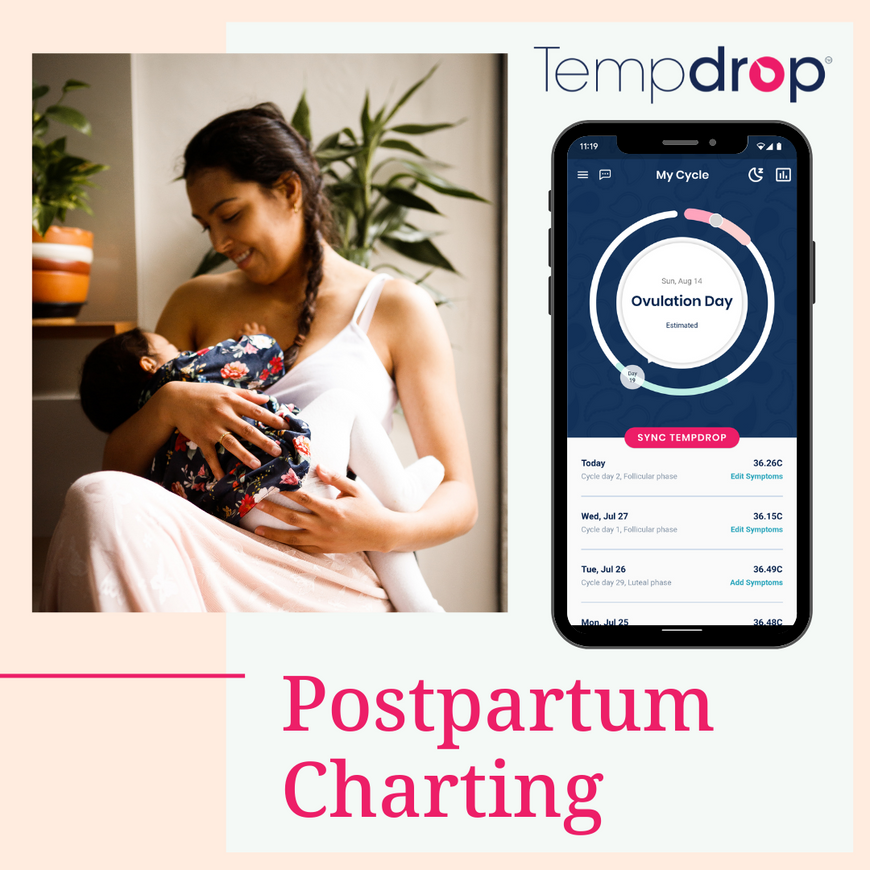
If I am exclusively breastfeeding, do I need to track ovulation and my other fertility signs?
There are three distinct rules that someone practicing Lactational Amenorrhea Method (LAM) needs to follow in order to have an effective birth control method:
- They must be breastfeeding exclusively, which means the baby’s mouth to their nipple rather than pumping and bottle feeding pumped milk. Baby must be feeding every 4-6 hours throughout the day and night
- They must have had no spotting or bleeding after their initial postpartum bleeding
- Their baby must be 6 months or younger

It's also important to remember that everyone is different, so still pay attention to your cervical mucus patterns during this time.
Can I use fertility awareness while breastfeeding?
Yes you can! Tracking your fertility postpartum can be an effective way of avoiding pregnancy and can cue you into when you've ovulated. Charting postpartum uses the same foundational knowledge, but different rules.
There is a heavier reliance on tracking your daily fertility levels via cervical mucus, as opposed to calculation rules or even temperature. Make sure you choose a method that has a specific protocol for postpartum. Some people may find a protocol like Billings, which relies on cervical mucus, or Marquette, which uses a LH and Estrogen monitor to be useful during postpartum charting.
When should I start charting again postpartum?
 This depends on how frequently you are breastfeeding. (As mentioned above if you are exclusively breastfeeding then you can follow the rules of LAM for the first 6 months.)
This depends on how frequently you are breastfeeding. (As mentioned above if you are exclusively breastfeeding then you can follow the rules of LAM for the first 6 months.)- If you are not breastfeeding at all, you will want to start charting at 2 weeks postpartum (or whenever the mood for sex returns). Remember you'll likely want at least a week or two of charting again before relying on it for any intention.
- If you are partially breastfeeding (which means you are breastfeeding but also supplementing with pumped milk or formula). Like in the last bullet, you will also want to start charting around 2 weeks postpartum (or whenever the mood for sex returns).
- If you are exclusively breastfeeding, you will want to start charting at 2 months postpartum, but ensure you are meeting all the rules for exclusive breastfeeding, and start charting sooner if fertility signs return or if any of the requirements for exclusive breastfeeding change.
When should I start taking my temperature postpartum?
This depends - BBT is still of benefit as it will help you confirm ovulation has indeed happened. But during your return of fertility, you may be tracking BBT for a very long time before you notice a temperature shift. For some who decide to add basal body temperature to their charts, they may wait until they notice a changing cervical mucus pattern, which indicates your hormones are changing and ovulation may occur (this all depends on your method, follow whichever method you choose).
The return of your fertility depends on your breastfeeding patterns, and whether you are exclusively breastfeeding, partially breastfeeding, or not breastfeeding at all. Approximately 60% of women will ovulate before they have their first period postpartum, which is why we recommend to work with an instructor to help identify the signs that indicate the return of your fertility.

An example of a Tempdrop chart showing nightly BBT & ovulation
What should I expect my charts to look like postpartum?
This means you’re basically in one very long pre-ovulatory phase following birth. The time it takes for the return of your fertility will be based on many factors and this can differ after each pregnancy. Just because your fertility returned at a certain time for your first baby, doesn’t mean you will follow the same pattern for subsequent postpartum time.
This is why working with an instructor to help understand your fertility patterns postpartum is key. It can be challenging to learn fertility awareness, on your own, during postpartum.
When my cycles do return, what should I expect?
You may notice a change in your cycles when your fertility does return, especially for the first few cycles. It’s important to pay attention to both cervical mucus and temperature (as always), because we need cervical mucus to back up our temperature observation, and vice versa.
When your cycles return, ovulation will be confirmed the same way it is always confirmed in your method - that part doesn’t change. However you may notice a change from what you were used to before conceiving. Things like your luteal phase length, your cervical mucus pattern and your cycle length may vary when your fertility does return.

In summary, expect the unexpected charting postpartum! And when in doubt, find a certified instructor to guide you through this unpredictable season of fertility!

